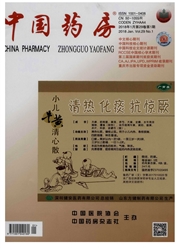

 中文摘要:
中文摘要:
目的:评价临床药师对眼科抗菌药物合理使用干预的效果。方法:派驻临床药师进入眼科开展临床药学服务,参与主任查房,开展临床抗菌药物使用监测评价、对医务人员和患者进行抗菌药物知识培训和宣教,调查临床药师开展药学服务工作前后眼科及其亚专业科室的出院人数和抗菌药物临床使用指标,据其评价临床药师的工作效果。结果:临床药师开展药学服务工作前后眼科月均出院人数由321人次增加至492人次(P〈0.05);抗菌药物使用率由83.39%下降为39.63%(P〈0.05),抗菌药物使用强度由14.99下降为11.55(P〈0.05),抗菌药物使用金额占药品使用金额比例由17.38%下降为9.27%(P〈0.05),使用抗菌药物病例的微生物标本送检率由0上升为6.15%(P〈0.05)。各亚专业科室相关指标也呈现类似变化,尤以白内障和斜视小儿眼科改善效果明显。结论:临床药师在眼科开展药学服务工作可以规范临床抗菌药物使用,促进医务人员提高合理使用抗菌药物的意识。
 英文摘要:
英文摘要:
OBJECTIVE:To evaluate the effects of clinical pharmacist intervention in rational use of antibiotics in eye clinic.METHODS:Clinical pharmacist was accredited into eye hospital to carry out clinical pharmacy services,participating the chief expert rounds,monitoring and evaluating the use of antibiotics,training medical staff and patients on the knowledge of antibiotics,surveying the number of hospital and clinical use of antibiotics indexes in eye hospital and subspecialty departments before and after the work of clinical pharmacists and evaluating the effects. RESULTS:The average number of discharged patients in eye hospital was increased from 321 to 492 monthly before and after clinical pharmacists work(P〈0.05);antibiotics usage was decreased from 83.39% to39.63%(P〈0.05);the intensity of antimicrobial drug use was dropped from 14.99 to 11.55(P〈0.05);the amount of antibiotics use was decreased from 17.38% to 9.27%(P〈0.05),the submission rate of antibiotics medical microbiological specimens was increased from 0 to 6.15%(P〈0.05). Each subspecialty departments also showed similar changes in related indicators,especially improved significantly in pediatric ophthalmology and strabismus cataract. CONCLUSIONS:Clinical pharmacists pharmaceutical care in ophthalmology can regulate the use of antibiotics and promote the medical staff to improve awareness of rational use of antibiotics.
 同期刊论文项目
同期刊论文项目
 同项目期刊论文
同项目期刊论文
 期刊信息
期刊信息
